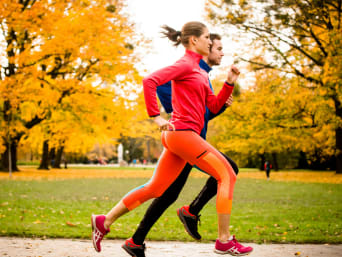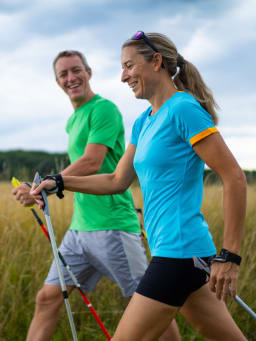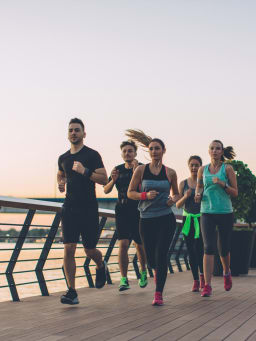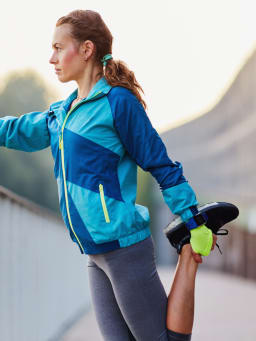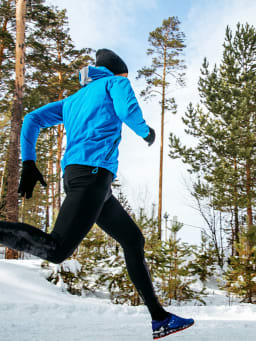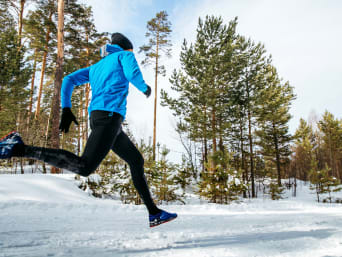Running for beginners: health benefits and training tips
Improving endurance and speed, promoting health, or simply leaving everyday life behind for a moment - every runner has their own personal goals and gets motivated in different ways. Whether you are a beginner or looking for new challenges, running has something to offer for every age and fitness level. In our guide, we will show you the health benefits of various running sports such as (Nordic) walking, jogging and trail running. In addition, we will give you step-by-step training tips to help you get started with running.
Is running good for you? The benefits of running
Running enables you to get regular exercise and fresh air, which can have numerous positive effects on your physical health and well-being. As a beginner you don’t need to reach peak performance right away. When it comes to running, training speed and intensity are secondary to maintaining your health. It is more important to train regularly and make sure you practise your running technique properly.
Staying healthy by running and jogging regularly
Jogging and running help you to stay fit. Running is considered a true all-rounder when it comes to promoting and maintaining good health. Even moderate running training can help you maintain a healthy weight, increase your fitness, and prevent health issues that can arise from lack of exercise.
However, as with any form of training, it is important that you do not overexert yourself and that you give your body enough time to recover. It doesn't matter if you haven't exercised for a while or if you are more mature. Starting off your running training gently will allow you to stay healthy and improve your fitness at any age and prevent a lot of health problems:
Running strengthens bones, tendons, and ligaments. The repetitive impact that running exerts on the bones stimulates bone formation and increases bone density. The risk of developing osteoporosis or osteoarthritis can be reduced through regular running training.
The cardiovascular system is stimulated. Running stimulates blood circulation and increases oxygen intake. This strengthens your heart and keeps your blood vessels supple, which can prevent heart disease.
Endurance training strengthens your lungs, which will increase your lung capacity. This means more oxygen can be taken in with one breath, which increases oxygen supply to your body.
Your immune system is strengthened if you exercise outdoors and pay attention to a healthy diet and recovery phases after exercising.
Take up (Nordic) walking to keep active and stay healthy
Compared to jogging and running, walking and Nordic walking are low-impact forms of exercise. This means that this type of training puts less stress on your joints.
People that are new to running, older people, or people with joint or bone diseases such as arthritis or osteoporosis may prefer to start walking as it iseasier on the body. Nordic walking or walking is a great way to help runners who are recovering from a sports injury to keep active and get back into exercising. Walking and Nordic walking also strengthen the cardiovascular system and the immune system in addition to the following health benefits:
Improved posture and balance.
Tension in the body can be released through gentle, steady training.
Muscles will become stronger and at the same time less pressure will be put on your bones and joints.
The use of Nordic walking poles mobilises the muscles and tendons of the upper body and neck.
Walking and Nordic walking will also boost your metabolism, which can have a positive effect on your blood sugar and cholesterol levels.
Running and general well-being
During sporting activities, the body releases endorphins and serotonin, which provide mental relaxation, a feeling of contentment, and inner balance. Running is one of the best ways to relieve the stresses of everyday life. Focusing on your body and the route ahead of you will quickly clear your mind. Every little victory, no matter how small, also makes you feel happy and will boost your self-confidence.
Jogging and running for beginners
Running is a versatile sport that you can do almost anywhere and almost all year round. When exercising in the fresh air, you not only improve your physical fitness, but your mood can also benefit from regular running. In this article we will explain how to get started with running and what gear you will need.
Walking and Nordic walking for beginners
(Nordic) walking is a low-impact sport that is easy on your joints and ideal for running novices of all ages to develop their flexibility. In this guide we will explain the difference between walking and Nordic walking, show you what equipment you will need and give you tips on how to get started.
Trail running for beginners
Trail running is a form of long-distance running in which you run on natural footpaths or mountain bike trails rather than on tarred roads. You can use these varied trails to set yourself unusual challenges, which is why this type of running is recommended for more experienced runners. We will explain what you should keep in mind when going from tarred roads to natural trails and what gear you will need.
Running training for beginners
A balanced workout combines different types of high intensity training. Gradually training your body to accomplish new challenges can help you safely improve your performance. Even advanced runners can benefit from incorporating different types of training and exercises into their routine. Different workouts can help you to continuously improve your training. In this article you will find an overview of the different types of training as well as exercises to improve your running form.
Running goals for beginners
When you first start out with running, you should set realistic goals for yourself. It is a good idea to work towards these goals step-by-step to avoid overdoing it and to stay motivated. Even advanced runners set themselves new challenges from time to time, for example running faster or longer distances. This means that your running routine will change over time. In the following article we will give you some ideas on how to create your own running routine and an example of a running plan for beginners.
Warm-up & cool-down exercises for runners
To take advantage of the health benefits of running, it is important to include warm-up and cool-down exercises in your training. A thorough warm-up prepares your muscles and joints for exercise, and it also reduces the risk of any injury. A cool-down, on the other hand, signals your body that it can start to relax again and start the recovery process. In the following article you will find suggestions for warm-up and stretching exercises for before and after your run.
Strength training for runners
Regular strength training is essential for runners. By doing strength and core workouts you will strengthen muscles groups that are not used as much when running. These muscles are vital for a stable core and an upright posture when running. This will not only improve your overall fitness level but will also help prevent injury and improve your running performance. In this article we will show you 11 strength exercises that you can do without any fitness equipment, making them easy to integrate into your workout.
Tips for running safely in winter
In autumn and winter, drizzle or cold weather does not stop a passionate runner from continuing their outdoor running routine. However, it is important to adapt the intensity of your running training to the colder temperatures and to choose the right functional clothing. In this article we will show you what you should look out for when running during the cold season.
______________________________________________
References and further information
https://dynamicphysio.co.nz/high-impact-vs-low-impact-exercise-which-is-right-for-you/
(Last accessed on 29.01.2024)
https://www.webmd.com/fitness-exercise/health-benefits-running#1
(Last accessed on 29.01.2024)
https://getoutside.ordnancesurvey.co.uk/guides/beginners-guide-to-nordic-walking/
(Last accessed on 29.01.2024)
https://www.outsideonline.com/health/running/culture/10-amazing-benefits-running-might-not-known/
(Last accessed on 29.01.2024)
https://www.runnersworld.com/nutrition-weight-loss/a25646745/running-for-weight-loss/
(Last accessed on 29.01.2024)
The image sources in this text are in chronological order:
Cover photo: iStock.com/Martinan
1. Image in text: iStock.com/Ridofranz
2. Image in text: iStock.com/Ivanko_Brnjakovic
3. Image in text: iStock.com/amriphoto
4. Image in text: iStock.com/swissmediavision
5. Image in text: iStock.com/dusanpetkovic
6. Image in text: iStock.com/svetikd
7. Image in text: iStock.com/dolgachov
8. Image in text: iStock.com/PeopleImages
9. Image in text: iStock.com/sportpoint
